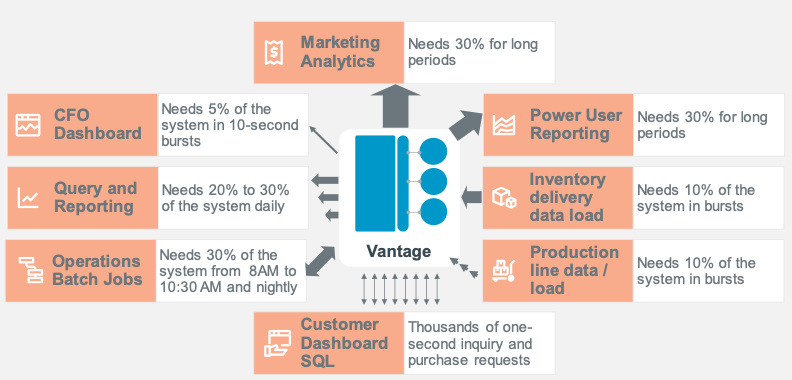Maximize throughput while keeping aligned with business priorities, with Vantage on Azure
Today’s enterprise systems support a diverse collection of workloads. Often these varied applications run at the same time on a single platform, each contending for resources and fighting for their piece of the action.
Complex analytics, ad hoc requests, business reporting, and batch jobs could all be executing as your marketing department is processing critical customer-facing dashboard queries and while transactions are streaming into your sales tables. Keeping the access to resources balanced across these different applications while maximizing the throughput of the platform and still being able to protect the SLAs of short-running requests is like trying to manage traffic in a large city—it takes effective rules and regulations.
Teradata’s dynamic resource optimization – also known as
workload management – provides techniques that are like traffic lights, one-way streets, and metered on-ramps that keep traffic from becoming gridlocked at rush hour in our big cities, but it does so inside the database.
 Enterprise Systems Have Many Demanding Users
Enterprise Systems Have Many Demanding Users
Teradata’s dynamic resource optimization didn’t spring up overnight. It evolved over time to match the growing sophistication of enterprise users and to respond to their increasingly complex mix of work. For example, the original Teradata Advanced SQL Engine (formerly known as Teradata Database) came with four different priority levels. Everything that was executed in the database ran at one of those four levels. Before Teradata users had even thought about needing workload management, the database itself used those contrasting priorities to control the level of resources being offered to different internal tasks and to influence the speed at which they were completed. Read more about prioritization in the Advanced SQL Engine
here.
Today, there are hundreds of different priority levels a user can draw upon, and special concurrency rules can easily be put in place to even-out surges in demand. Some of the
y key features of today’s workload management include:
- Prioritization, which allocates resources based on specific business requirements
- Exception handling that dynamically reduces the priority of poorly-behaving requests
- Concurrency control rules; to give users control over what runs, when it runs, and how much of it runs
- Limits on the level of CPU and I/O that a workload can consume
- Ability to protect critical online application performance and load job SLAs while all other work is active
- Automatic rule changes to accommodate different needs at different times of the day or month
- Detection and reaction to unusual system events or extreme resource usage
Teradata dynamic resource optimization is extensible and simple to modify. Users can be assured that whatever growth and change comes their way, they will be able to adapt the Teradata workload management rules easily.
Teradata Vantage on Azure
To be clear, the same array of dynamic resource optimization tools that are available with Teradata Vantage on-premises are also available with
Teradata Vantage on Azure. This implies that customers do not have to settle for “basic” cloud data warehouses that do not have advanced workload management capabilities and hence require customers to create separate data marts (read: separate data silos) in order to handle enterprise scale, concurrent workloads.
With Teradata Vantage on Azure, customers have access to the same industry-leading dynamic resource optimization tools that they have come to love with the added agility that Azure brings to the table as a hyper-scale, hybrid cloud vendor.
A customer example
A leading consumer electronics retailer needed to extend the capabilities of its on-premises system, as well as their increased focus on Data Governance, Risk and Compliance (DGRC), coincided with their desire to move to the cloud for better agility. They viewed Vantage on Azure as the best solution to protect their existing data platform, ensure the continuity of business operations, and protect the large amount of customer data on-premises.

“Workload management and best database out there! [Other solutions] could not handle the workload for queries that Teradata does; it could not even come close.”
For more information on Teradata Dynamic Resource Optimization today, view this short video
here.
For additional use cases and key features of Vantage on Azure, please visit
https://www.teradata.com/Cloud/Azure.
Violet Le is a Marketing Director at Teradata currently covering co-marketing activities with AWS, Azure and GCP. She has 18 years' of marketing experience in the IT industry, ranging from world's leading brands to small firms, covering every aspects of marketing. She held an MBA from Southern Methodist University and an MS from the University of Texas at Austin. She is bilingual in Chinese and English.
View all posts by Violet Le
Neeraj Jain is the Product Lead for Teradata on Azure cloud offerings. He has 10+ years of enterprise product management experience in successfully launching and managing of large-scale products in globally distributed firms involving cross functional teams with diverse technical backgrounds. He holds a Master’s degree from University of Maryland in Systems Engineering.
View all posts by Neeraj Jain
(Author):
Carrie Ballinger
Carrie Ballinger is a Vantage Certified Master with over 30 years with Teradata, currently working in performance optimizations within the engineering organization. During her tenure, she has focused extensively on workload management, MAPS, and other database technologies. Carrie is the author of more than 32 technical Orange Books, the most recent one on Native Object Store, and provides regular technical blog postings here on Teradata.com and on Teradata Community.
View all posts by Carrie Ballinger